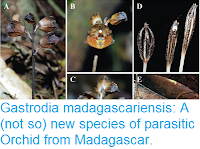Epidendroid Orchids, Epidendroideae, are the largest subfamily of Orchids, with over 15 000 described species, more than all other Orchid groups combined. The majority of these species are epiphytic (live on other plants, typically in the canopy of rainforest trees), though terrestrial forms are known. The group is found across the globe, with the exception of the polar regions, the deserts of Africa, Arabia and Australia, and the southern part of South America. The genus Coelogyne contains about 200 species predominately found in South and Southeast Asia, as well as on the islands of the Pacific as far east as Fiji and Samoa.
In a paper published in the journal PhytoKeys on 29 June 2017, Ye Lwin Aung of the State Key Laboratory of Systematic and Evolutionary Botany at the Institute of Botany of the Chinese Academy of Sciences, Xiaohua Jin, also of the State Key Laboratory of Systematic and Evolutionary Botany at the Institute of Botany of the Chinese Academy of Sciences,and of the Southeast Asia Biodiversity Research Institute of the Chinese Academy of Sciences, and André Schuiteman of the Science Directorate at the Royal Botanic Gardens, Kew, describe a new species of Coelogyne from Kachin State in Myanmar.
The new species is named Coelogyne putaoensis, meaning 'from Putao', in reference to Putao, the northernmost town in Myanmar and the closest to the locality where the new species was discovered. The species as found growing in the Hponkanrazi Wildlife Sanctuary, in an area of subtropical montane rainforest, at altitudes of between 2500 and 3100 m. It is a rhizomatous herb with leaves reaching 9.5 cm in length, found growing both epiphytically on the trunks of trees and epilithically upon rocks. It has solid brown flowers, which enable it to be distinguished from other members of the genus growing in the same area, all of which have flowers with striped patterns.
Close-up of flower of Coelogyne putaoensis, showing the white papillae on the two lateral lamellae. Xiaohua Jin in Aung et al. (2017).
Only a sigle population of the new Orchid was discovered, comprising about 200 individual plants. However the location where it was found is not thought to be under any particular threat, and forms part of a large (2700 square kilometres) reserve, so Aung et al. do not believe that the species faces any immediate conservation threat.
See also...
Follow Sciency Thoughts on Facebook.







